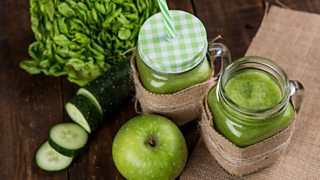How has tech changed the way we eat?
When we think of “food technology”, our minds are probably drawn to delivery apps like Deliveroo, Just Eat and Uber Eats – either that or school cookery lessons where the end result of our labour was a plastic tub of slightly sweaty scones.
But the movers and shakers in the food tech world aren’t just influencing how we access food, they’re also rethinking what we eat. In Human Error, comedian Olga Koch and journalist Hussein Kesvani delve into futuristic tech, and how it can impact on our lives. In this episode the pair whet our appetites (or not) for the latest innovations to hit our plates. Here are some of the culinary creations they uncovered.
Liquid Lunches
Huel is probably not news to those with half an eye on the adverts that populate their social media feeds. But for the uninitiated, Huel, or human fuel, is a meal replacement that comes in the form of a nutritionally complete powder. That is to say, the mix of oats, peas, rice, coconut, flaxseed and sunflower seeds contains all the carbohydrate, protein, fats, fibre, vitamins and minerals we need. Fans of the meal substitute are called Hueligans. Huel also comes as bottled drinks, bars, protein snacks, and a hot meal option. Rather than taking the time to make or buy lunch, you just add water to the powder and swig it down. Tasty.

The clean aesthetic of it represents a selling strategy that’s not ‘come taste this food it’s delicious’, it’s more like … ‘this is the cleanest thing you can have’.
Square meals
Does the idea of switching your sandwich for powder and water have you crying out for a good square meal? Be careful what you wish for. Enter Squareat. Described as a “revolutionary meal plan”, Squareat is for those who want their food to look less food-like. Boxes of ready-to-eat, portion-controlled meals are delivered to your door – oh, and each constituent part is a 50g compact, squidgy… square. You can combine a chicken square, a basmati rice square and a broccoli and spinach square to make a jigsaw-esque lunch, and follow it up with a choco pancake square for pudding. These portable, long-life squares contain all natural ingredients that are simply compressed into a square shape. They’re reminiscent of astronaut food, but without the excitement of being in space.
Hussein suggests that the “cleanness” of the squares is part of their appeal. “The clean aesthetic of it represents a selling strategy that’s not ‘come taste this food it’s delicious’, it’s more like … ‘this is the cleanest thing you can have’. It represents this much broader anxiety about our bodies, and our desire to control [them] in a world that’s becoming more chaotic.”
Internet-connected juicers
Juicero has to be one of the most Silicon Valley inventions to come out of Silicon Valley. Its premise was that customers would buy packets of diced fruit and vegetables, which would be plugged into a specially-designed, wifi-connected machine that would squeeze them into juice. The handy accompanying app would even notify you when your “produce packs” were about to go out of date (information which you could also read for yourself on the sachets.) Things started to go downhill for Juicero when users realised that, instead of relying on a $399 machine to press their fruit juice, they could simply squeeze the packets with their bare hands to the same effect. Juicero, like their produce packs, felt the squeeze and shut down.
The future of food

Futuristic food supplements offer the promise of time, gained from the loss of prepping, cooking and eating. Their subscription models take away the effort of food shopping, and the thought that goes into meal planning is done for you. Weight management is taken care of too, as the nutritional value of these meals, whether square or powdered, can be taken for granted. But Olga reflects that “cuisine is so much more than just fuel.” If we lose the time it takes to sit down and enjoy a meal with family or friends, we miss out on other great life experiences too. Gone is the excitement of trying new cuisines and ingredients, the comfort of a favourite meal, the therapeutic process of baking, and the joy of sharing something you love with someone you love. Different cuisines have huge cultural significance to so many people. They can reflect family traditions and regional identities. They enable the sharing of skills and secrets. As Hussein points out: “Food tech says the communal element of eating is not important. It’s just about the optimisation. It’s a very individualistic notion of what consumption, and food, is.” These convenient, nutritious meal swaps may buy you the gift of time, but is it worth it at the expense of the loss of pure enjoyment, culinary traditions and shared experiences? If you eat to live, you may think so, but not if you live to eat.
-
![]()
Human Error: Food Tech
Olga Koch and Hussein Kesvani give us a taste of the latest innovations in food tech.

More on the science behind food from �������� Sounds
-
![]()
Inside Health: Ultra-processed vegetarian & vegan foods
Ultra-processed vegan and vegetarian foods may look healthy, but are they? James Gallagher investigates.
-
![]()
Just One Thing with Michael Mosley: Change Your Mealtimes
Why changing when you eat can boost metabolism, help you lose weight and improve sleep.
-
![]()
The Curious Cases of Rutherford & Fry: The Pizza Diet
Is it possible to make a pizza that contains the recommended daily intake of everything?




